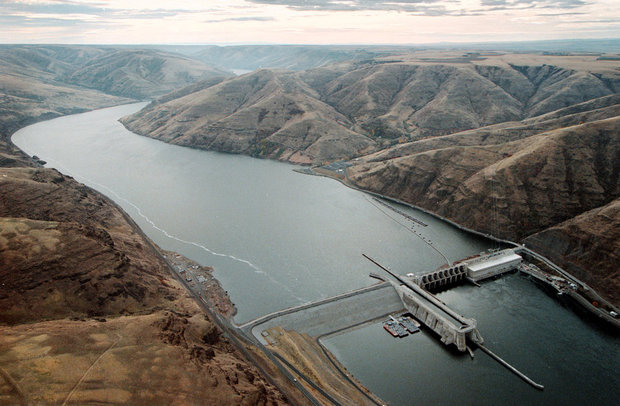forum
library
tutorial
contact

Free-flowing Rivers are
Essential to Our Region's Health
by Paul Lindholdt
Spokesman-Review, February 10, 2018
|
the film forum library tutorial contact |

|
Free-flowing Rivers are
by Paul Lindholdt
|
 Imagine hovering high above the drainage of the Columbia, that great river in the West. Its sprawling watershed includes all of Idaho, most of Washington, large parts of British Columbia, Montana and Oregon. Tributary rivers, streams and creeks pulse like arteries and capillaries.
Imagine hovering high above the drainage of the Columbia, that great river in the West. Its sprawling watershed includes all of Idaho, most of Washington, large parts of British Columbia, Montana and Oregon. Tributary rivers, streams and creeks pulse like arteries and capillaries.
Much like arteries, the tributaries help shuttle lifeblood from the heartland out to the continent's coast. Much like veins, clouds from the Pacific Ocean trundle wetness back to our inland core. The Columbia River is a drudge because 14 major dams congest it. In its watershed ranging north and east, dozens of upcountry dams emboss its tributary streams like bad bling on a cashmere jacket.
Kris Johnson recently published a partisan op-ed in The Spokesman-Review ("Dams balance energy, wildlife needs," Jan. 27). As president of the Association of Washington Business, Ms. Johnson is solicitous of business interests. She neglects sustainability to assist her constituents. That's her job. She falsely argues that the four lower Snake River dams help salmon recover. Her frail argument uses "alternative facts" and demonstrates how out of step she is with other citizens in the region.
Federal judges and regional governors - not to mention every conservation group in the nation - regard those dams as the worst of the worst. They block 500 miles of prime spawning habitat in wild Idaho. Those dams remain in place so a few farmers can ship their grain. At the same time, billions of dollars are being spent by the Bonneville Power Administration and state agencies to recover threatened salmon downstream.
The news from Idaho ought to alarm even Ms. Johnson and those farmers. Runs of anadromous fish in the Snake, Clearwater and Salmon rivers were so small in early 2017 that Idaho Fish and Game restricted fishing to catch-and-release. Any so-called "harvest" of steelhead or salmon, whether wild or hatchery-raised, would put their populations too much at risk. Midseason, though, yielding to business interests, IDFG reversed its hive-mind. It allowed dead fish to be toted home.
Then an unexpected event occurred. Fly-fishing groups organized to oppose all Idaho harvests. Fishermen and -women who wade in wild waters know something the business promoters and officeholders seem unable to acknowledge: Dams impede the lifeblood of the land. That oceangoing fish are the counterparts of healthy red blood cells thronging in the planet's body.
The crowds of opponents to the four lower Snake River dams are growing every year. Fly-fishermen, Indians, judges, journalists, merchants and voters on the coast recognize threats those dams pose. In the Salish Sea, orca populations are at a 30-year low point. So-called killer whales depend on healthy salmon stocks to thrive. The entire food chain depends on them. Nor are fish alone at risk.
Dams also add to climate change. An article in Smithsonian ("The Costs and Benefits of Hydropower ," Jan. 5) noted, "Aging reservoirs have become inefficient . . . and research suggests that hydropower reservoirs may be a much larger contributor of methane - a greenhouse gas roughly 30 times more potent than carbon dioxide - than previously realized." Organic material gathers in dam reservoirs, consumes oxygen and discharges methane.
Alternative facts from Snake River dam apologists notwithstanding, there is cause for hope. That hope rests with the Columbia Inter-Tribal Fish Commission, a project of the Nez Perce, Umatilla, Upper Columbia, Warm Springs and Yakama tribes. Those tribes are leading the way on salmon recovery. The tribes observe that "it will take everyone who lives in the basin to restore the salmon." Locals need to seize control of their destinies. In a hopeful sign also this year, 21 tribes got the U.S. Supreme Court to agree to hear a case on culverts blocking fish migration in Washington state.
Some people's hearts get clogged from bad food. From lack of exercise or genes that make them weak. Medical providers then need to carve side channels to help those clogged hearts plug away.
Consider dam breaching the landscape-scale equivalent of heart-bypass surgeries. Procedures that allow blood to flow free again, and the rivers to enjoy refurbished circulation. Ignore alternative facts. Vote out resistant politicians. Let's keep the good stuff flowing, the liquids lifting off and drifting back down - the systole and diastole by any other name performing the complex circulatory work.
learn more on topics covered in the film
see the video
read the script
learn the songs
discussion forum
